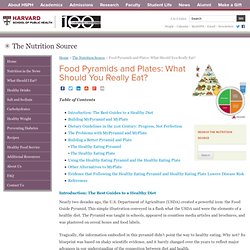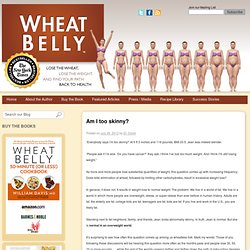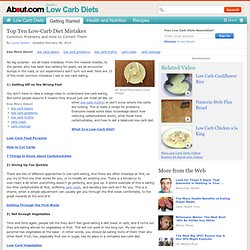

Food Pyramids: What Should You Really Eat? - What Should You Eat? Table of Contents Introduction: The Best Guides to a Healthy Diet Nearly two decades ago, the U.S.

Department of Agriculture (USDA) created a powerful icon: the Food Guide Pyramid. This simple illustration conveyed in a flash what the USDA said were the elements of a healthy diet. The Pyramid was taught in schools, appeared in countless media articles and brochures, and was plastered on cereal boxes and food labels. Tragically, the information embodied in this pyramid didn’t point the way to healthy eating. The USDA retired the Food Guide Pyramid in 2005 and replaced it with MyPyramid—basically the old Pyramid turned on its side, sans any explanatory text. The good news is that these changes have dismantled and buried the original, flawed Food Guide Pyramid and its underwhelming MyPyramid successor.
As an alternative to the USDA’s nutrition advice, faculty members at the Harvard School of Public Health built the Healthy Eating Pyramid. Building MyPyramid and MyPlate. Am I too skinny? “Everybody says I’m too skinny!”

At 5 ft 3 inches and 116 pounds, BMI 20.5, Jean was indeed slender. “People ask if I’m sick. ‘Do you have cancer?’ They ask. I think I’ve lost too much weight. As more and more people lose substantial quantities of weight, this question comes up with increasing frequency. In general, it does not. Standing next to fat neighbors, family, and friends, Jean looks abnormally skinny. It’s surprising to see how often this question comes up among us wheatless folk.
If you are among the few who truly are too slender, consider increasing calories from fat and protein–more eggs, meats, cheese, olive oil, avocados; consider strength training, since approximately a third of lost weight is lost muscle that can be easily regained; consider adding back modest quantities of non-wheat carbohydrates such as wild rice, sweet potatoes, and quinoa (1/2 cup is a safe quantity for most people; more and small LDL particles are triggered, as are higher blood sugars). Low-Carb Diet Mistakes - Correcting Problems on Your Low-Carb Diet. No big surprise - we all make mistakes.

From the newest newbie, to the person who has been low-carbing for years, we all encounter bumps in the road, or our experiments don't turn out well. Here are 10 of the most common mistakes I see in low-carb eating. 1) Getting Off on the Wrong Foot You don't have to take a college class to understand low-carb eating. But some people assume it means they should just eat meat all day (or other low-carb myths) or don't know where the carbs are lurking. What Is a Low-Carb Diet? Low-Carb Food Pyramid How to Cut Carbs 7 Things to Know about Carbohydrates 2) Giving Up Too Quickly There are lots of different approaches to low-carb eating, and there are often missteps at first, as you try to find one that works for you, or to modify an existing one.
Wired in the Floribbean. Diet. How fructose builds belly fat - 60 Minutes.